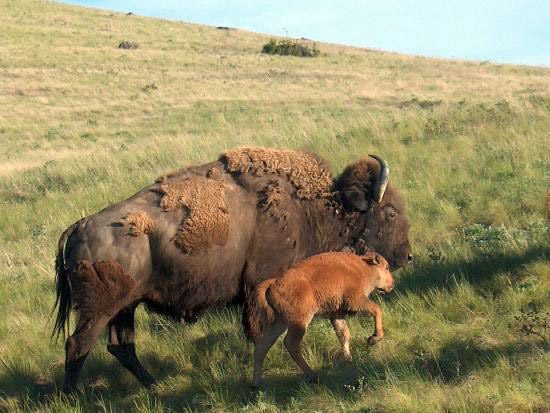November 3, 2024 – WASHINGTON – The Department of the Interior’s U.S. Fish and Wildlife Service, Parks Canada, Environment and Climate Change Canada and Mexico’s Secretariat of Environment and Natural Resources recently signed a new agreement to strengthen cooperation and coordination for the conservation of the American bison across its range in North America. Through a Letter of Intent, the countries will work to pursue bison conservation, restore ecological processes, and support traditional human use of natural resources with a particular focus on the unique historical connection between bison and Indigenous peoples.
This Letter of Intent was worked on at the recent Canada/Mexico/United States Trilateral Committee for Wildlife and Ecosystem Conservation and Management held in San Diego, California and outlines additional collaboration across national borders towards the United States, Mexico and Canada’s shared goal of domestic bison conservation. The Trilateral Committee began in 1996 as a pioneering initiative among the three countries to align efforts safeguarding North America’s wildlife and ecosystems. The committee’s Species of Concern Working Table brings together state, federal and Tribal resource managers and non-governmental organizations to share their expertise and coordinate conservation of species that span the continent.
“While the overall recovery of bison over the last 130 years is a conservation success story, significant work remains to ensure that bison will remain a viable species,” said Secretary Deb Haaland. “Our collaborative efforts with Canada and Mexico are an important step forward as we work to restore this majestic species and facilitate the return of bison to Tribally owned and ancestral lands.”
The recently signed Letter of Intent outlines the various ways that the three North American nations will work together, including by:
Improving collaboration on regional activities to promote policies, practices and effective methods in support of the ecocultural conservation of bison;
Promoting joint work plans within the Trilateral Committee’s Species of Common Conservation Concern working table;
Fostering transparency about the technical information that is developed jointly; and
Streamlining reporting on activities conducted under the Letter of Intent with the Executive Table of the Trilateral Committee for its review.
These international efforts will continue to build on the Interior Department’s domestic bison restoration efforts, including the Grasslands Keystone Initiative. In 2023, Secretary Haaland issued a Secretary’s Order and announced a $25 million investment to empower the Department’s bureaus and partners to use the best available science and Indigenous Knowledge to help restore bison across the country. The Order formally established a Bison Working Group (BWG) composed of representation from the five bureaus with bison equities: the Bureau of Indian Affairs, Bureau of Land Management, U.S. Fish and Wildlife Service, National Park Service, and U.S. Geological Survey. The BWG is developing a Bison Shared Stewardship Plan, which will establish a comprehensive framework for American bison restoration, including strengthening long-term bison conservation partnerships. Central to the development of that plan will be robust engagement with Tribes, including prioritizing Tribally led opportunities to establish new large herds owned or managed by Tribes and Tribally led organizations.
The American bison once thrived across the largest original distribution of any native large herbivore in North America, ranging from desert grasslands in northern regions of Mexico to interior Alaska. After North America’s European settlement, bison populations were reduced from an estimated 60 to 80 million to a mere 1,000 animals. These surviving bison were saved from extinction and became the founders of several protected populations that put the species on a path of recovery and conservation.
On Friday, bison remain absent from nearly 99 percent of their historic range. Most of the bison in North America are in herds that are constrained by fences, isolated from each other, and have fewer than 1,000 individuals, raising concerns about their genetic integrity, wildness and long-term viability of the species.
Approximately 31,000 bison are currently being stewarded by the United States, Canada and Mexico with the goal of conserving the species and their role in the function of native grassland systems, as well as their place in Indigenous culture.
Source & photo: DOI
Source link : http://www.bing.com/news/apiclick.aspx?ref=FexRss&aid=&tid=6727863fb15c4a85ba0cac105a874514&url=https%3A%2F%2Fgoldrushcam.com%2Fsierrasuntimes%2Findex.php%2Fnews%2Flocal-news%2F61721-interior-department-strengthens-conservation-of-american-bison-through-new-agreement-with-canada-and-mexico&c=193685416973624431&mkt=en-us
Author :
Publish date : 2024-11-03 00:49:00
Copyright for syndicated content belongs to the linked Source.
